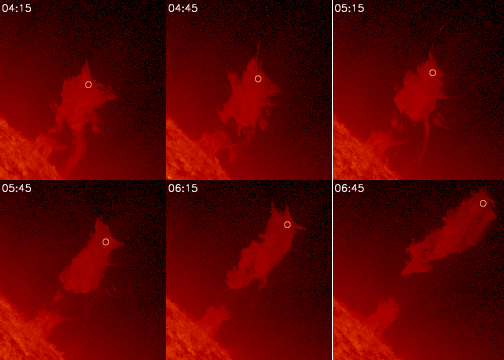Undergraduate student contributes to improved plasma diagnostic in eruptive prominences from SDO/AIA observations

Evolution of the 2010-06-13 prominence eruption. The circle marks the part of the prominence which was tracked. The field of view in the images is 300 × 300 arcsec.
Theoretical calculations have shown that when solar prominences move away from the surface of the Sun, their radiative output is affected via the Doppler dimming or brightening effects. In this paper co-authored between Dr Nicolas Labrosse and undergraduate student Kris McGlinchey we ask whether observational signatures of the changes in the radiative output of eruptive prominences can be found in EUV (extreme ultraviolet) observations of the first resonance line of ionised helium at 304 Å. We also investigate whether these observations can be used to perform a diagnostic of the plasma of the eruptive prominence. We find that observations of intensities in various parts of the four eruptive prominences studied here are sometimes consistent with the Doppler dimming effect on the He II 304 Å line. However, in some cases, one observes an increase in intensity in the 304 channel with velocity, in contradiction to what is expected from the Doppler dimming effect alone. The use of the non-LTE models allows us to explain the different behaviour of the intensity by changes in the plasma parameters inside the prominence, in particular the column mass of the plasma and its temperature.
This work is also described in this UKSP nugget.